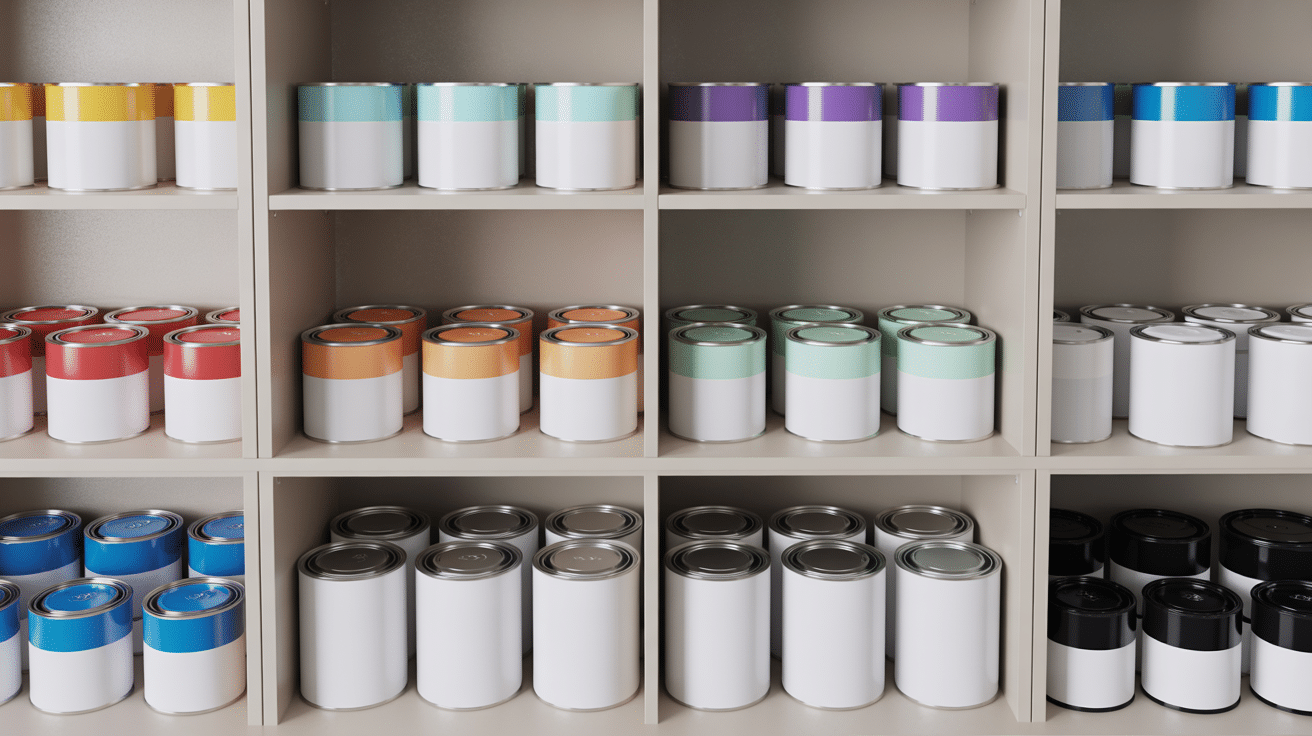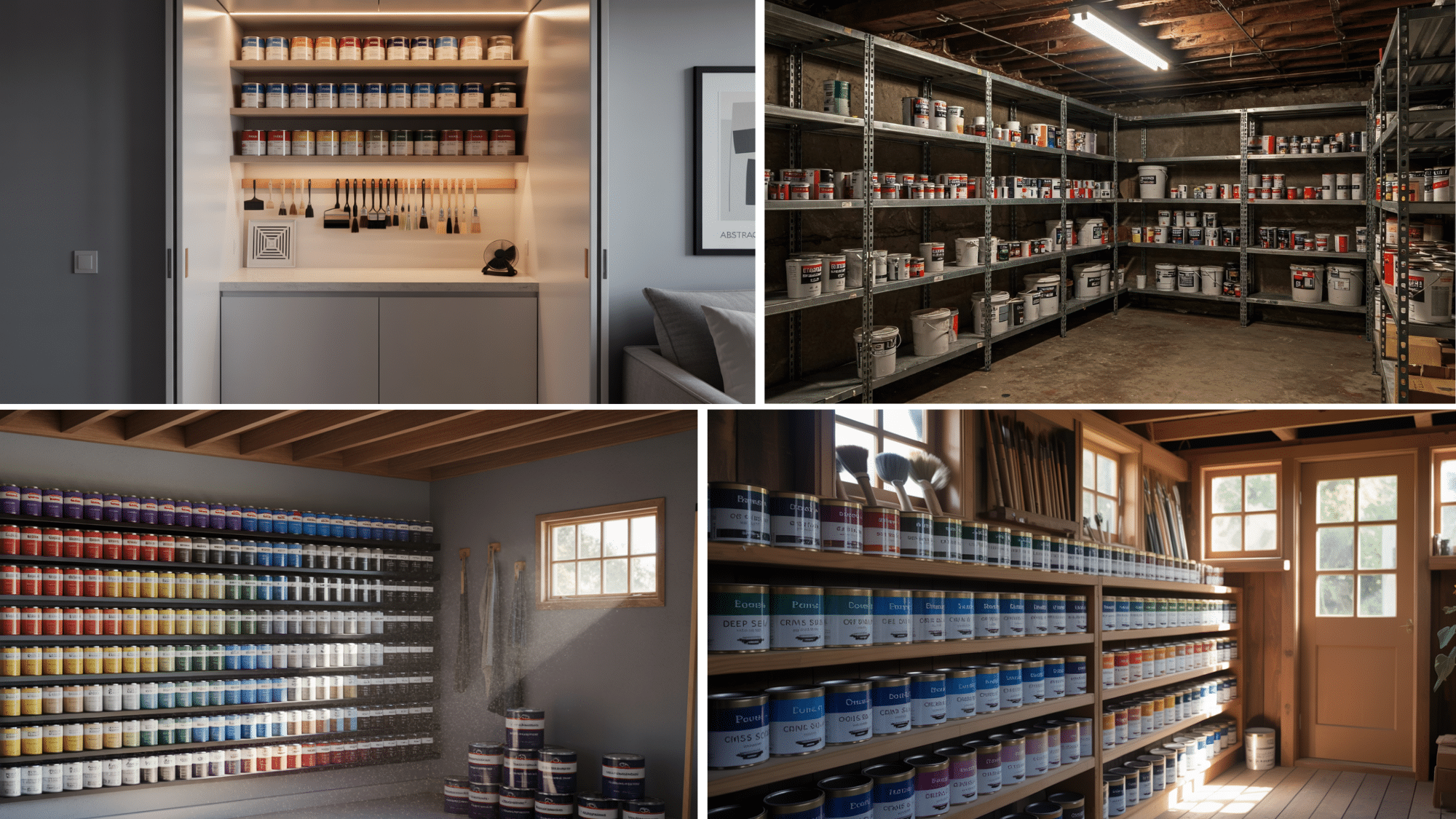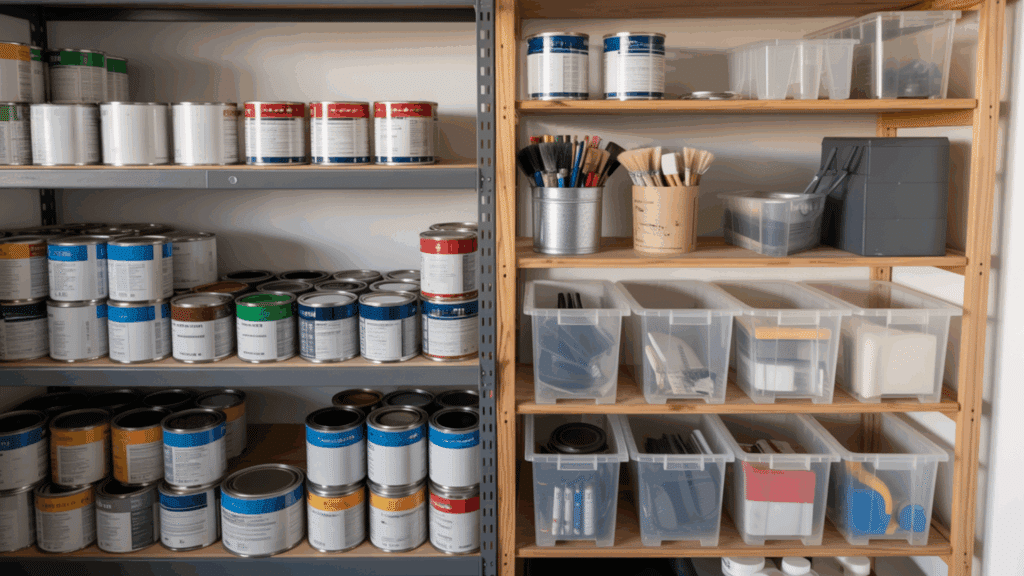Are you tired of tripping over scattered paint cans in your garage?
Most DIY enthusiasts face the common problem of half-empty paint cans taking up space without a proper home. Finding what you need quickly becomes impossible when cans are stacked randomly.
This guide will walk you through practical solutions to organize your paint collection.
From simple DIY shelving to clever labeling systems, you’ll learn how to change your messy paint corner into an efficient storage zone that makes your next project easier.
Benefits of Proper Storage

Most homeowners know the frustration of searching through a jumble of paint cans. They pile up after projects – some full, some half-empty, some nearly dried out.
Paint cans scatter across garage floors, basement corners, and workshop shelves without any real system. This chaos makes finding the right color for touch-ups nearly impossible.
Good paint storage matters for several key reasons.
- First, it makes valuable space usable again.
- Second, proper organization means quick access when touch-ups are needed.
- Third, good storage actually extends paint life by keeping cans in the right conditions.
Paint stored correctly can last years longer than neglected cans. Paint can storage isn’t just about tidiness; it’s about creating a functional system that works for your needs.
Paint Can Storage Ideas for Every Space

When working with a sprawling garage, a damp basement, or a compact apartment, finding the right paint can storage solution is all about balancing space, safety, and convenience.
Below, we break down smart, space-specific ideas to help you store paint cans properly no matter where you live.
Garage Storage Solutions
Most homeowners find the garage a logical spot for paint storage. It offers easy access and usually has wall space that can be utilized.
However, garages experience temperature fluctuations that can impact paint quality over time. Despite this drawback, many still prefer garage storage for convenience.
Wall-mounted racks work well in garages, keeping cans off the floor and visible at a glance.
Steel cabinets provide better protection from temperature swings while still keeping paints organized. Raised shelves create a dedicated paint station without sacrificing floor space for cars or other tools.
Basement Storage Options
Basements offer more stable temperatures than garages, making them better for long-term paint storage. The consistent cool environment helps maintain paint quality. However, moisture concerns can’t be ignored in below-grade spaces.
For basement storage, homeowners should use sealed containers or plastic bins to protect against dampness. Raised shelving units keep paint cans off potentially damp floors, protecting against minor floods or moisture issues.
The stable temperature makes basements ideal for paints that might be stored for years.
Indoor Storage for Apartments or Small Homes
People in apartments or small homes face different challenges but gain the benefit of climate-controlled spaces.
Indoor storage means paints won’t freeze in winter or get too hot in summer, significantly extending shelf life. Space limitations require creative solutions, like under-sink cabinets in utility rooms or dedicated closet space with proper ventilation.
Sealed containers become even more important to prevent paint odors from spreading through living areas.
Workshop Storage Solutions
Dedicated workshop spaces allow for customized paint organization systems. Pegboard walls can hold specialty racks designed specifically for paint cans.
Adding a small counter space nearby creates a mixing station, making the entire paint process more efficient.
Temperature-controlled workshops offer the perfect balance of accessibility and preservation.
Shed Organization
Garden sheds can be transformed into paint storage areas with proper shelving. While temperature control is limited, insulated sheds provide better protection than uninsulated ones.
Creating a dedicated paint corner away from garden chemicals prevents cross-contamination. Raised platforms are essential to protect against ground moisture and flooding.
How to Organize Paint Cans
1. Sort strategically – Group paints by project (kitchen remodel, exterior), by room (bedroom, living room), or by type (primer, latex, oil-based).
2. Label everything – Create clear labels showing color name, brand, finish, room used, and date opened.
3. Transfer small amounts – Pour leftover paint into mason jars or specialized paint containers to save space and extend shelf life.
4. Use visual systems – Add color-coded dots to can tops for quick identification or dip paint stirrers in each color and attach to cans.
5. Create a paint inventory – Maintain a simple spreadsheet or notebook with paint names, locations, and amounts remaining.
6. Add paint swatches – Brush a small amount on the label or lid for instant color recognition.
7. Organize by frequency – Keep frequently used paints at eye level, occasional paints on lower shelves.
8. Date your containers – Mark purchase and opening dates to track age and usability.
9. Separate by priority – Create “keep” and “dispose” sections to periodically review which paints to keep.
Key Tips for Organizing Your Paint Cans Effectively
I’ve learned through many home projects that keeping paint cans in good shape saves me time and money. When I store my leftover paint properly, I can use it for touch-ups years later.
Here are my top tips for keeping your paint fresh and well-organized:
- Clean the rim before closing, tap lids firmly with a rubber mallet, and add plastic wrap for an extra air barrier.
- Store paint in consistent temperatures (50-80°F), choose basements over attics, and avoid humidity to prevent rust.
- Include paint name, brand, finish, room used, purchase date, and add color swatches on lids for quick identification.
- Store cans standing up on elevated shelving rather than on concrete floors, with heavier cans on the bottom rows.
- Keep paint away from water heaters, furnaces, and windows to prevent pressure buildup and potential leaks.
Final Thoughts
Tackling paint can storage doesn’t need to be a major project. Even small improvements in organization can make a big difference in workspace safety and efficiency.
Just sorting paints by type or adding simple labels can save hours of frustration on future projects.
Why not set aside a few hours this weekend to change that paint clutter? Start with one area, implement a system that works for your space, and enjoy the satisfaction of finding exactly what you need when you need it.
What paint storage solutions have worked in your space? The perfect system is the one you’ll actually maintain.


















